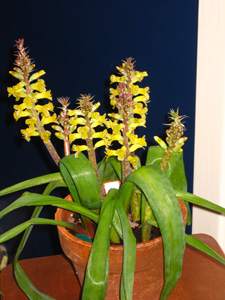Resource Library
Plant of the Week: Romand Cape Hyacinth
The University of Arkansas System Division of Agriculture does not promote, support or recommend plants featured in "Plant of the Week." Please consult your local Extension office for plants suitable for your region.
Plant of the Week
Romand Cape Hyacinth
Latin: Lachenalia aloides ‘Romand’

During midwinter, especially when the weather is close, chill and dull, it is sometimes difficult to maintain the cheer possessed by most gardeners. But then I stumble out to my little cold greenhouse and find plants starting to bloom and am instantly reawakened to the hopeful spirit that lives in every gardener. Today, I happened upon the cheery yellow blossoms of Romand Cape Hyacinth (Lachenalia aloides ‘Romand’) and was again renewed.
Romand Cape Hyacinth is a tender bulbous plant from South Africa that belongs to the newly created hyacinth family. Lachenalia is a diverse genus of about 110 species of bulbous plants found in the southwestern part of South Africa in areas with a mild Mediterranean climate – namely, cool and moist winters and blistering hot and dry summers. The various species are winter-blooming in the Southern Hemisphere, producing flowers from April through September in their native homeland. When grown in the Northern Hemisphere, the Lachenalia are winter bloomers with flowering from December until April. For me, Romand has bloomed consistently during the past three winters in mid-January. But by regulating forcing techniques, bloom time can be adjusted.
This clone produces 50 cent-sized fleshy white bulbs that produce a pair of fleshy, inch-wide and six inch-long leaves that, in well-nourished plants forced in a cool climate, are marked with large brown spots. The leaves appear before the plant flowers and disappear when temperatures begin to climb in the greenhouse. The plant has been dormant for me by late May.
In Romand, the brown-speckled scape is to 12 inches long with 40 to 50 inch-long, bright yellow tubular flowers. Plants remain in bloom for three weeks and have a faint spicy fragrance. ‘Rupert’ has purple blooms, while ‘Rosabeth’ has cherry colored blooms. These and other cultivars are part of the “African Beauty” series licensed by Dutch bulb forcer J.H. van der Vossen. There are at least 25 hybrid Lachenalia in the trade, many of which involve either L. aloides or L. bulbifera as part of their parentage.
Lachenalia bulbs were first collected in 1652 when traders from the Dutch East India Company first entered the interior of South Africa looking for new bulb species that could be grown in Holland. During the next century, they became a part of the collector market for rich Europeans but were not systematically studied until Baron Nicholas Joseph Jacquin studied a collection at gardens of Schönbrunn Palace in Vienna, Austria. He created the genus Lachenalia in 1784, naming it after a well known Swiss professor, Werner de Lachenal.
Lachenalia never became much appreciated and always remained a minor collector bulb until scientists at the Roodeplant Vegetable and Ornamental Plant Institute of the South African Agricultural Research Council decided to try to commercialize it as a new crop for greenhouse forcing. Initial breeding work was started in 1965, with the first clones released about 1980. Since 1990, Institute scientists have developed propagation, production and marketing protocols for the new crop. Though uncommon in American markets – at least in the central part of the country – it is developing as a part of the spring flowerpot trade in Europe.
I potted my Romand Cape Hyacinth bulbs after receiving them from Brent and Becky Bulbs in Virginia during the fall of 2009. Using just ordinary greenhouse potting soil, they were planted in a six-inch pot in mid-October and placed in my cool greenhouse, which is kept between 45 and 50 degrees at night. Flowers appeared in about 12 weeks from planting, even at the cool temperatures. A greenhouse is not needed for forcing – any cool well-lighted window sill should work just as well. When I bring my plant inside to warmer temperatures, the scapes stretch out and the plant is not as attractive as it would be if kept cool during the flowering period.
Lachenalia bulbs require frequent watering during the forcing period to keep the foliage from wilting. Though I have not routinely fertilized my plants, others say they benefit from a supply of balanced liquid fertilizer during the forcing period. When the bulbs die down in late spring, I leave the pot inside the greenhouse to keep it warm and dry during the summer. My green0house has summer shade, so it never gets above 100 degrees. Too much moisture during the summer months will lead to bulb rot. When I bring in my other greenhouse plants in during October, I begin watering the pot again, and so far it has bloomed on schedule each winter. Though I have not tried it, new bulbs can be started by means of leaf cuttings.
By: Gerald Klingaman, retired
Retired Extension Horticulturist - Ornamentals
Extension News - February 3, 2012
The University of Arkansas System Division of Agriculture does not maintain lists of retail outlets where these plants can be purchased. Please check your local nursery or other retail outlets to ask about the availability of these plants for your growing area.